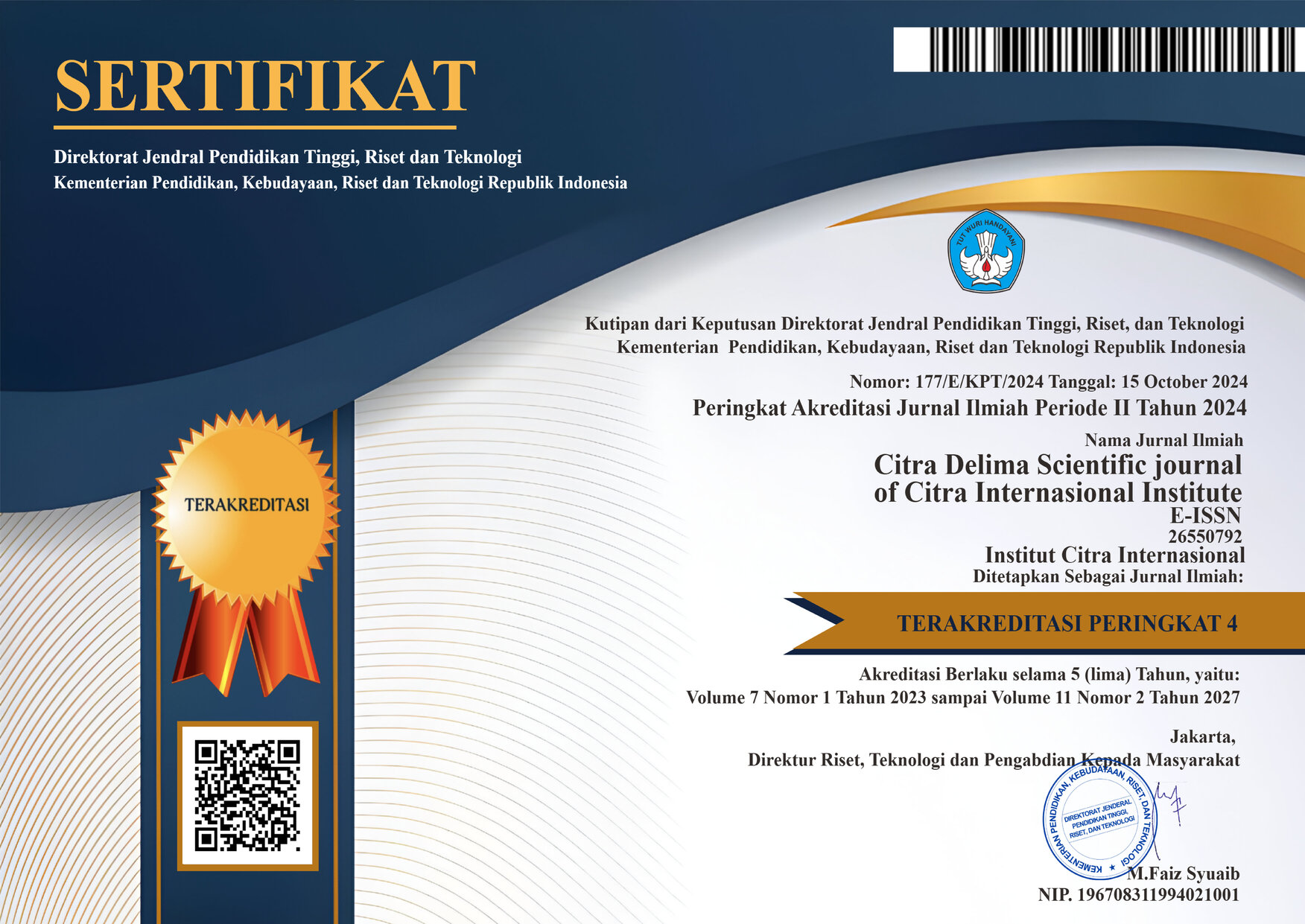Dampak Cemas Terhadap Kesehatan Reproduksi Pekerja Wanita Usia Subur
DOI:
https://doi.org/10.33862/citradelima.v8i2.414Keywords:
Anxiety, Depression, Reproductive, Women, WorkerAbstract
Based on figures from the Central Statistics Agency, the percentage of women as professional workers will decrease by 1.34% in 2022. Previously it was 49.99% to 48.65%. Workers with a high depression/anxiety index were 100% and an average of 89.5% experienced reproductive health problems. The aim of this research is to determine the impact of depression/anxiety on reproductive health in female workers of childbearing age. Women of Childbearing Age (WUS) with an age range of 15-49 years. This research method is Mixed Methods with a strategy that is embedded concurrently and uses gradual quantitative-qualitative data analysis. The sample in this study was 10 women of childbearing age. Based on the results of the Self-Reporting Questionnaire (SRQ)-20 test conducted on a sample of 10 female workers of childbearing age, the results showed that 3 respondents experienced depression/anxiety. The results of in-depth interviews (In-Depth Interviews) show that depression/anxiety has an impact on the reproductive health of female workers of childbearing age, such as irregular menstrual cycles and pregnancy disorders. The conclusion of this study is that there is a relationship between depression/anxiety and the reproductive health of women of childbearing age. The researcher's advice to all women is to keep trying to do positive things when experiencing depression/anxiety and to consult further with experts.
Downloads
References
Harlina, Y. M. (2015). Teori Kesehatan Reproduksi. Yogyakarta: Deepublish.
Hidayah, F. N. (2023). Persentase Perempuan Indonesia yang Menjadi Tenaga Profesional Turun 1,34% Pada 2022. https:/ data.goodstats.id/statistic/Fitrinurhdyh/persentase-perempuan-indonesia-yang-menjadi-tenaga-profesional-turun-134-pada-2022-BJDcX
Idaiani, S. (2009). Analisis 20 Self Reporting Questionnare pada Masyarakat Indonesia. Pusat Penelitian dan Pengembangan Bio Medis dan Farmasi. Badan Kebijakan Pembangunan Kesehatan.
Ilham Alhaq Hazani, R. T. (2019). Peran Pekerja Perempuan dalam Meningkatkan Pendapatan Keluarga Migran di Kecamatan Ilir Barat I Kota Palembang. Jurnal Kependudukan Dan Kebijakan, 7 (2).13-29. https://doi.org/10.22146/jp.55146
Ilham Safar, N. (2019). Stres Kerja Buruh Perempuan Di Kota Makassar. Jurnal Sinar Manajemen,(6)1. 20-26 https://doi.org/10.56338/jsm.v6i1.547
Kominfo, D. (2023). Dinas Komunikasi dan Informatika Provinsi Jawa Timur. https://kominfo.jatimprov.go.id/berita/jumlah-perempuan-usia-kerja-di-jatim-meningkat-0-74
Muslimin, I. G. (2019). Faktor-faktor yang Berhubungan Dengan Terjadinya Stres Kerja Pada Pekerja Wanita. Jurnal Kesehatan. 10 (2). 13-27. https://doi.org/10.38165/jk.v10i2.13
Novra Isranda, Hasan Husin, Henni Febriawati, Wulan Angraini. (2011). Pengaruh Kecemasan Dan Dukungan Sosial Terhadap Perilaku Kesehatan Pegawai Kesehatan Kabupaten Rejang Lebong. Journal of Physics A: Mathematical and Theoretical. 1 (1). 25-31. doi: 10.1088/1751-8113/44/8/085201
Proverawati, A. (2009). Menarche Menstruasi Pertama . Yogyakarta: Nuha Medika.
Rizal, M. (2016). Hubungan Stres Kerja Dengan Menstruasi Abnormal Pekerja Konveksi Desa Pegandon Pekalongan. Unnes Journal of Public Health. 5 (3) . 205-214. https://doi.org/10.15294/ujph.v5i3.10400
Safar I, Nurdin. (2019). Work Stress Of Women Construction Workers In Makassar. Jurnal Sinar Manajemen. 6 (1), 20–26. https://doi.org/10.56338/jsm.v6i1.547
Sudarman, Tendean, Hermie. (2021). Faktor-Faktor Yang Berhubungan Dengan Terjadinya Preeklampsia. e- Clinic. 9 (1). 91–99. doi: 10.35790/ecl.v9i1.31960
Suryawan, K. D. (2018). Analisis Faktor-faktor yang Mempengaruhi Stres Kerja Pada Tenaga Kebersihan Kota Di Dinas Lingkungan Hidup Kabupaten Gianyar Tahun 2017. Jurnal Pendidikan Ekonomi Undiksha. 10 (1). 1-11. https://doi.org/10.23887/jjpe.v10i1.20035
Zuliana, N. R. (2019). The influence work periods and knowledge of 5S to the 5S implementastion at logistic section in heavy equipment fabrication company GRESIK. Malaysian Journal of Medicine and Health Sciences. 15 (3). 1-166 https://openurl.ebsco.com/EPDB%3Agcd%3A4%3A4976084/detailv2?sid=ebsco%3Aplink%3Ascholar&id=ebsco%3Agcd%3A141975195&crl=c
Downloads
Published
Issue
Section
License
Copyright (c) 2025 Febyona Jolest Puteri, Henni Febriawati, Emi Kosvianti, Nopia Wati, Weti

This work is licensed under a Creative Commons Attribution-ShareAlike 4.0 International License.







.png)





